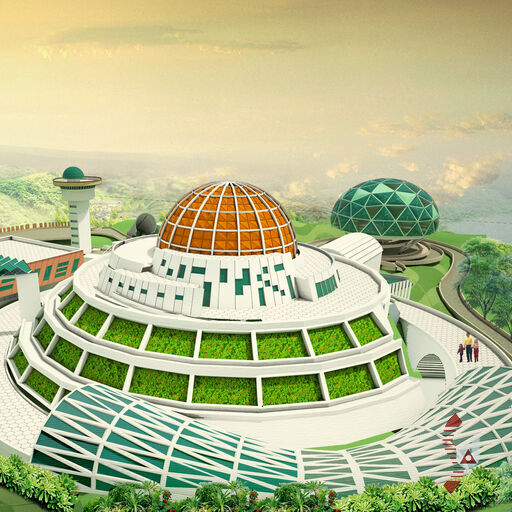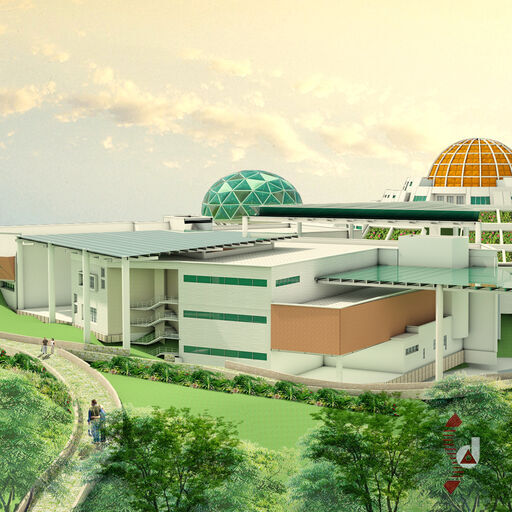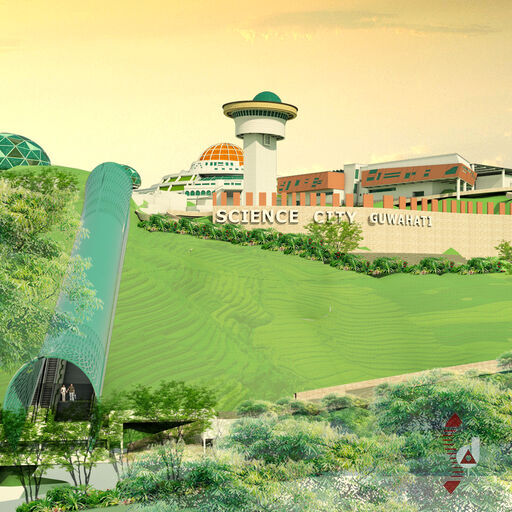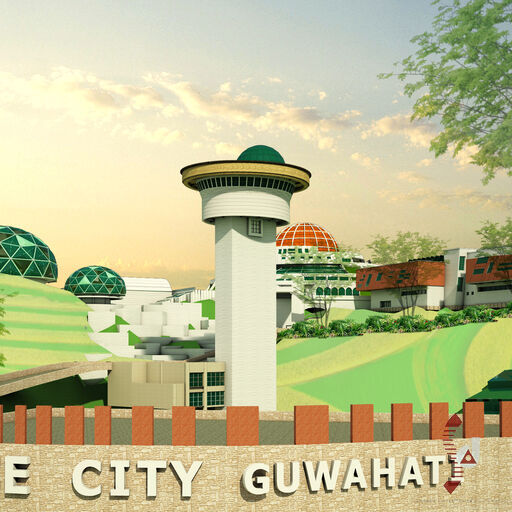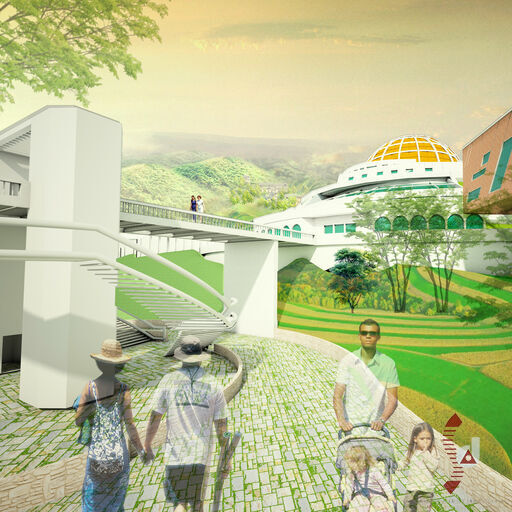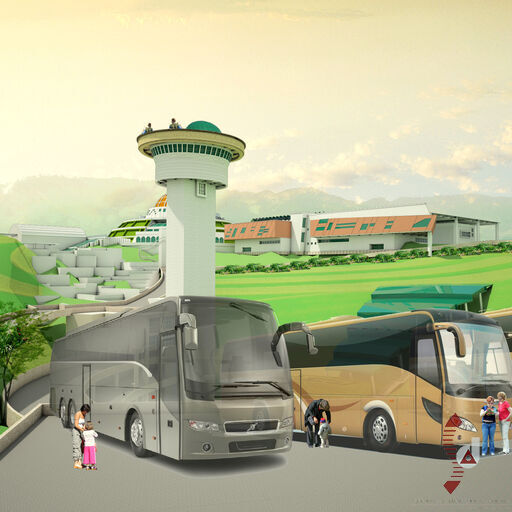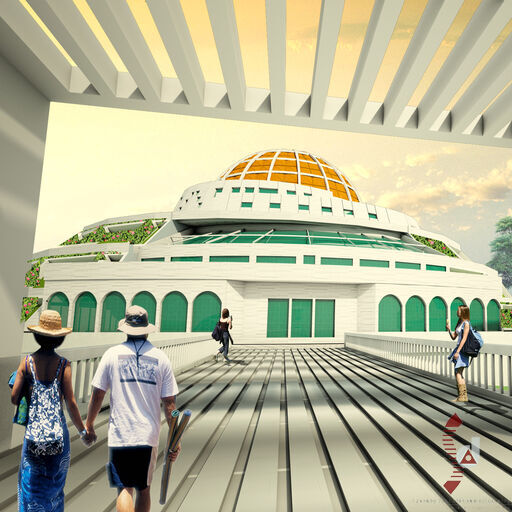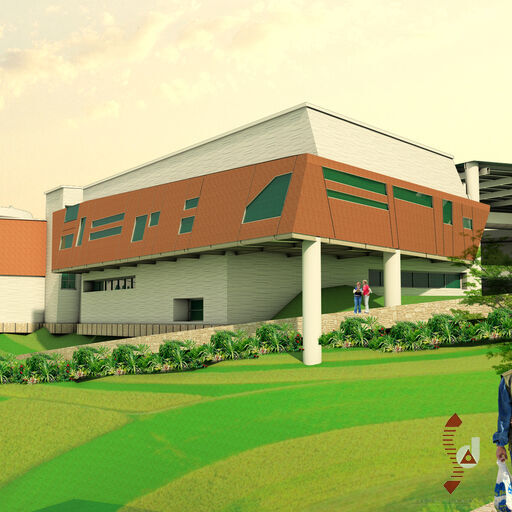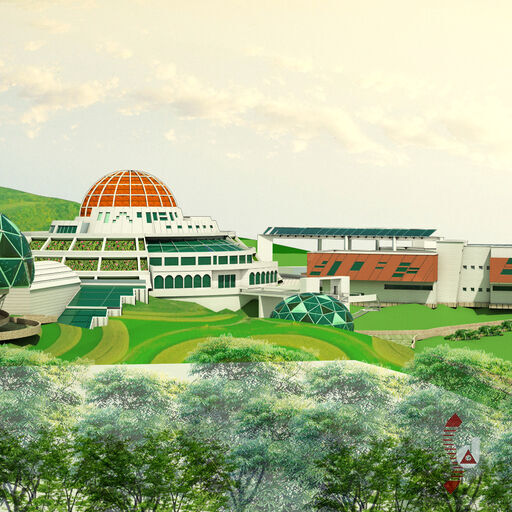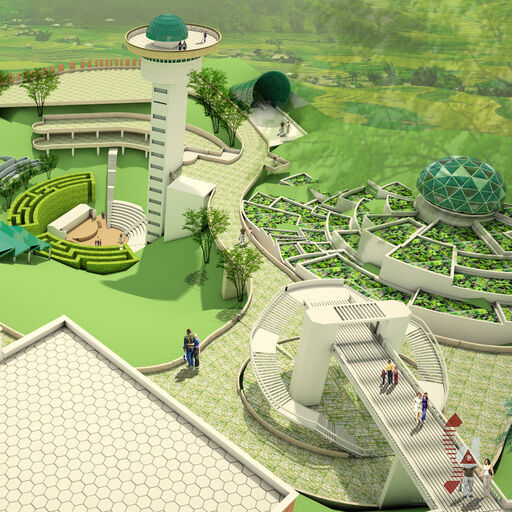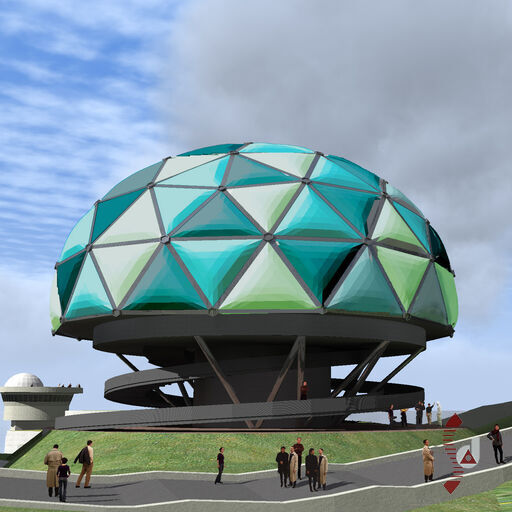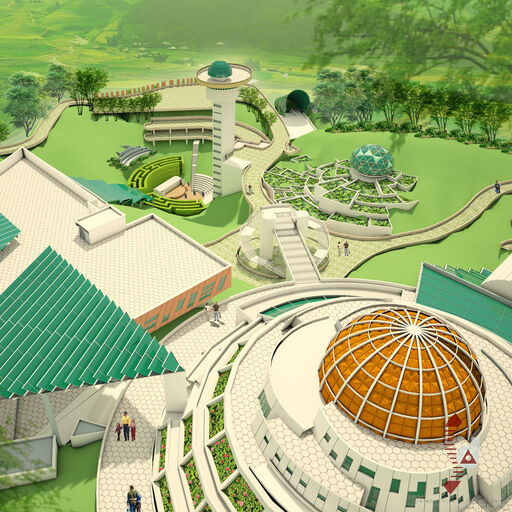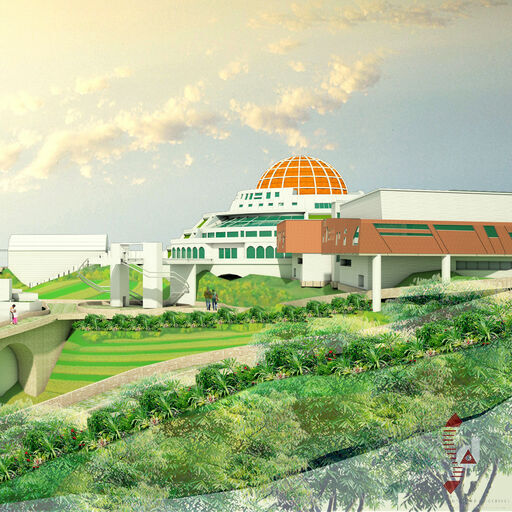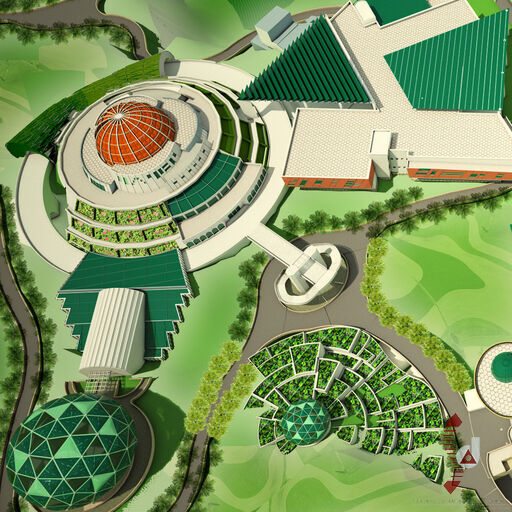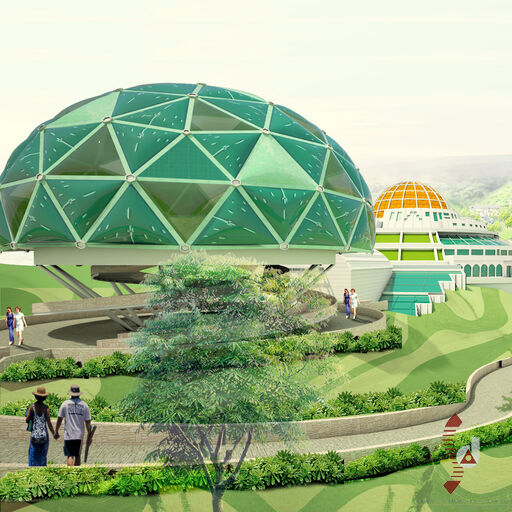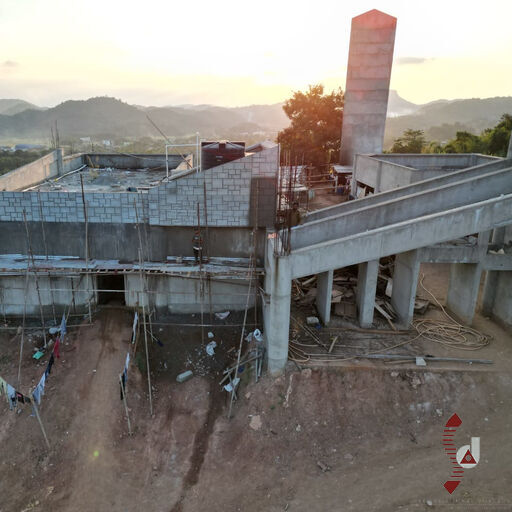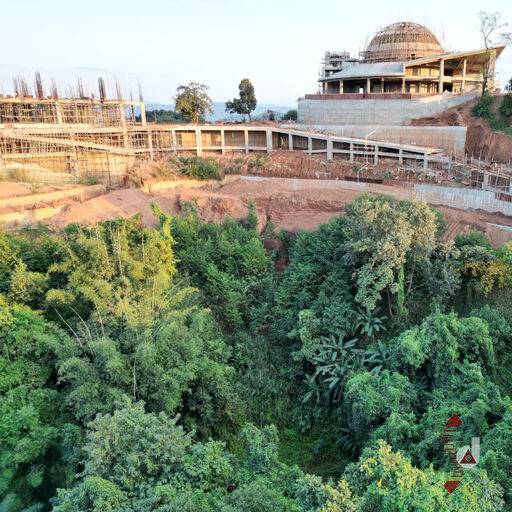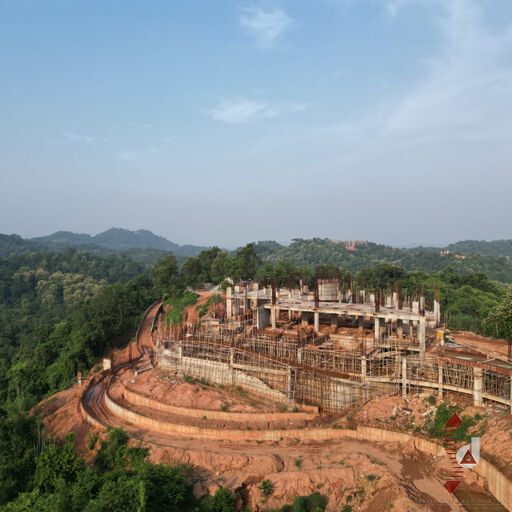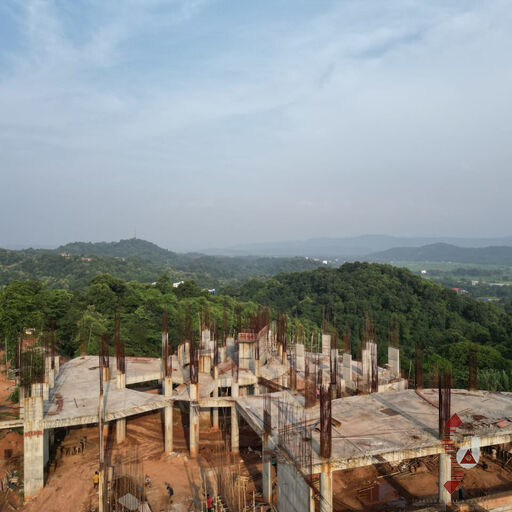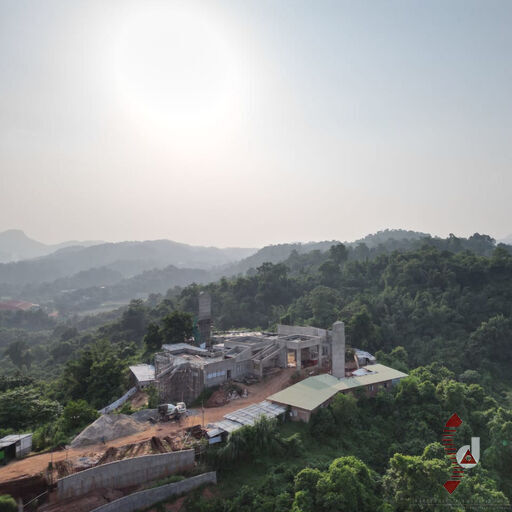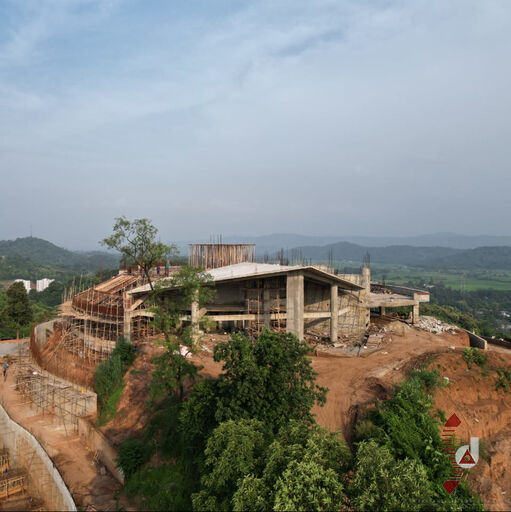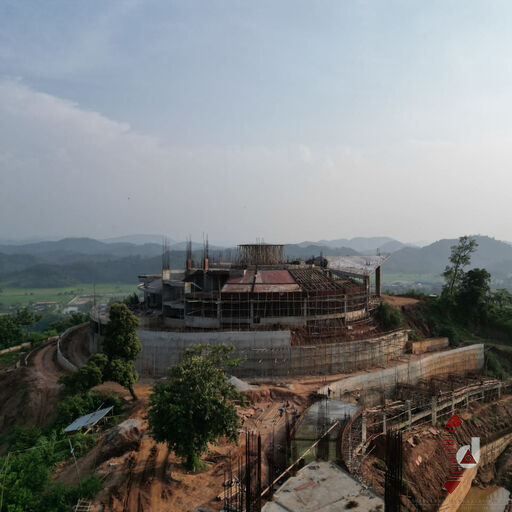Science City Guwahati is Institutional architectural project designed by SDAARCHITECT, located in Guwahati, Assam.
Project Info
| Client |
National Council of Science Museums Assam Science Technology and Environment Council |
|---|---|
| Project Type |
Institutional |
| State |
Assam |
| City | Guwahati |
| Consultants |
CECON SM Associates Soni Consultants |
| Team |
Sunando Dasgupta Swarnali Roy Deepanshu Singh Jaskrit Kaur KBL Seth |
| Style |
Futurist Monumental |
| Status | Under Construction |
| Scale | Extra-Large-Scale Projects |
Architectural Renders
Project Photographs
Site Analysis
Location
The site for the Science City is located in Tapesia village, Sonapur circle, Guwahati, Assam. It is situated 22 km from the city center and 3 km south of National Highway 37. The geographical coordinates are latitude 26°7’ N and longitude 91°55’ E. The site is positioned on a hill range extending towards the Brahmaputra River to the north, the Khasi Hills of Meghalaya to the south, and a broad plain basin to the west.
Elevation
The proposed site is situated on a hill range with elevations ranging from 115 m to 200 m above a 100 m-highway. The highest hill in the area reaches up to 216 m. Temperature variation at the highest point is under 1°C, and panoramic views are available from this elevation.
Geology
The geology of the site is influenced by its proximity to the alluvial plains and hills surrounding Guwahati. The area is part of the ancient Gondwana landmass and is positioned at the edge of hard rock formations. Geological types include gneisses, granite, pegmatite, and quartz veins. The Brahmaputra valley features alluvial plains with silt, sand, clay, and pebble-beds, while the hilly regions contain iron ore, quartz, and felspar.
Landform and Slope
The site features two hills running southwest to northeast and another southeast to northwest, forming a horseshoe saddle with a natural drainage system. The terrain includes gorges and a bowl-shaped swale with varied hill profiles. Major buildings are planned for the flatter top of the southwest-northeast ridge, while parking and light structures will be placed on the slopes. The southwest-northeast ridge will host the Science Centre, Dome Theatre, Food Court, Digital Panorama, Aquarium, Aviary Dome, and Butterfly Garden, while the southeast-northwest ridge will feature the Gate Complex.
Steep slopes limit construction to ridges and light structures in swales. Building elevations are carefully selected to suit the slope and landform, with entrance levels at 150 m, parking plaza at 145-139 m, gate complex at 173 m, guest house at 165 m, and major buildings such as the main science centre and dome theatre situated at 183 m and 193 m, respectively.
Steep slopes make pedestrian ramps impractical due to the increased travel distance required. Instead, vehicular access will be used for goods, VIPs, and emergencies. Vertical cores with lifts and stairs are incorporated for efficient access between levels, enhancing visitor experience and accessibility.
Aspect and Climatic Impact
The orientation of slopes and aspect have been analyzed for their impact on energy efficiency, including sun path, wind directions, and precipitation. Guwahati's climate is influenced by its location in the Southeast Asiatic monsoon region. The city experiences cold, foggy winters, cool springs, hot and humid summers, and pleasant autumns. Temperatures can reach up to 38°C in summer and drop to 10°C in winter. The year is divided into four seasons:
- March to May (Spring): Dry with low humidity; dusty in March; rain and thunderstorms common in April and May. Temperatures range from 12°C to 31°C.
- June to August (Summer): Hot and humid with significant rainfall. Temperatures range from 25.5°C to 33.3°C.
- September to November (Autumn): Pleasant with less rainfall and fog. Temperatures range from 21°C to 31°C.
- December to February (Winter): Cool with occasional showers. Temperatures range from 10°C to 24°C, with mist in the mornings and evenings.
Soil Erosion
The rapid human settlement around Guwahati in recent years has led to deforestation, land filling, and loss of wetlands, resulting in increased flooding, siltation, and severe waterlogging during monsoons. The proposed site has three natural drainage systems flowing northeast, southeast, and southwest. To mitigate soil erosion and landslides, measures include maintaining natural drainage channels, increasing wetland depth, preserving natural forests, and installing an interconnected drainage network in gardens and parks.
Prevention of landslides involves avoiding disturbance or blockage of natural drainage, using support walls with a wider base and effective weep holes, and avoiding steep vertical faces and additional load near slope edges.
Design Concept
Master Plan Parameters
The Master Plan for the Science City in Guwahati has been developed with several key parameters to ensure optimal use of the site and effective visitor experience:
- Maximize Use of Flat Areas: The design prioritizes the use of flatter areas on the site to accommodate major facilities and minimize the impact of the site's topography.
- Proper Vehicular and Pedestrian Access: Ensures that gradients are appropriate for both vehicles and pedestrians, facilitating smooth movement across the site.
- Optimize Cutting and Filling: Strategically planned to manage earthworks for ramps, roads, and infrastructure, reducing environmental impact and construction challenges.
- Minimize Disturbance to Natural Flora and Fauna: The design aims to preserve the natural landscape and ecosystems, avoiding unnecessary disruption to local flora and fauna.
- Avoid Disrupting Natural Water Flows: The layout is designed to maintain existing natural water courses and drainage patterns, preventing potential flooding and erosion issues.
- Effective Visitor Interaction and Circulation: Facilities are arranged to enhance visitor engagement and ensure efficient circulation through the Science City.
- Vertical Levels: Due to the site's steep contours and limited flat land, the Science City will feature 3-4 vertical levels, interconnected by ramps and staircases rather than mechanical lifts.
Major Levels and Zones
The Science City is organized into distinct zones, each serving specific functions and designed to align with the site's topography:
Zone I: Entry Plaza and Surroundings
Entry Plaza: Located at +150 m elevation, this area features security facilities, a toll room, and pedestrian entry with security checks. It connects to the parking plaza, convention centre, and pedestrian ramps leading to the Gate Complex.
Parking Plaza: Comprising three levels—top for buses, middle for cars, and bottom for two-wheelers—this area also includes an exposition space for open-air exhibitions.
Convention Centre: Positioned at +150 m elevation, this facility includes VIP rooms, conference rooms, a 400-capacity auditorium, convention hall, and an open-air theatre. It is strategically located for easy access and visibility from the highway.
Zone II: Gate Complex
Gate Complex: Located at +173 m elevation, this zone includes security checks, a cloak room, ticketing, an interpretation centre, and a multi-cuisine cafeteria. Access is facilitated via a pedestrian ramp, staircase, and a vehicular road that connects to the Science Park and other key areas.
Zone III: Main Science Centre
Main Science Centre: Situated at +183 m elevation, this zone features multiple exhibition halls, a 3D hall, science simulators, and various educational spaces. It is connected visually and axially with the Dome Theatre and Digital Panorama, and includes a large plaza for visitor movement.
Digital Panorama and Aviary Dome: Located at +183 m elevation, this area includes digital panoramic screenings, an aquarium, and the Aviary Dome. It enhances the aesthetic appeal and provides educational value.
Zone IV: Dome Theatre
Dome Theatre: Positioned at +193 m elevation, the Dome Theatre includes a spherical theatre, cafeteria, and various exhibition areas. Access is provided via escalators and ramps from lower levels, with a pedestrian plaza offering panoramic views of the surroundings.
Zone V: Recreational and Natural Areas
Recreational Areas: Located on a steep slope (+130 m elevation), this zone includes a musical fountain, picnic areas, geological and fossil parks, rock climbing areas, nature trails, and other outdoor exhibits. The design uses the natural slope and water flow for minimal environmental impact.
Zone VI: Guest House
Guest House: Located at +165 m elevation, this facility provides accommodation including guest rooms, suites, and a dining area. It is accessible via a road sloping from +168 m to +165 m, connecting to the Entry Plaza and Gate Complex.
Zone VII: Science Park
Science Park: Situated on the western edge of the site, this zone is dedicated to enhancing edutainment and science knowledge. It is connected by a pedestrian ramp from the Gate Complex and serves as an interactive and educational space.
Site Layout
Overview
The site for the Science City in Guwahati is characterized by a complex topography, which significantly influences its layout and design. The site encompasses a total area of 2,15,303 square meters, with specific allocation in Tapesia village, Sonapur circle, Guwahati, Assam. The area includes hills, gorges, and plains, presenting unique opportunities and challenges for the layout.
Site Zones and Elevations
The layout is divided into several zones, each designed to utilize the site's natural contours and elevations:
Zone I: Entry Plaza and Surroundings
Entry Plaza
Located at an elevation of +150 meters, this zone includes a security room, toll room, and pedestrian entry with security checks. It connects to the parking plaza, convention centre, and pedestrian ramps leading to the Gate Complex.
Parking Plaza: Comprising three levels, the top level is designated for buses, the middle for cars, and the bottom for two-wheelers. It also features an exposition area for open-air exhibitions.
Convention Centre: Positioned at +150 meters, it includes a VIP room, conference room, auditorium, and convention hall, with an open-air theatre on the roof. It is designed for ease of access and visibility from the highway.
Zone II: Gate Complex
Gate Complex: At an elevation of +173 meters, this area features security checks, a cloakroom, ticketing room, interpretation centre, and a multi-cuisine cafeteria. Access includes a 4-meter-wide pedestrian ramp and a vehicular road, connecting to the Main Science Centre and Dome Theatre.
Zone III: Main Science Centre
Main Science Centre: Located at +183 meters, this zone includes exhibition halls, a 3D hall, science simulators, and educational spaces. It is connected to the Dome Theatre and Digital Panorama, and features a large plaza for visitor movement.
Digital Panorama and Aviary Dome: At +183 meters, this area includes a digital panoramic screening and an aquarium, enhancing the educational and visual experience for visitors.
Zone IV: Dome Theatre
Dome Theatre: Situated at +193 meters, the Dome Theatre features a spherical theatre, cafeteria, and various exhibition areas. Access is via escalators and ramps from lower levels, with a pedestrian plaza offering panoramic views.
Zone V: Recreational and Natural Areas
Recreational Areas: Located on a steep slope at +130 meters, this zone includes a musical fountain, picnic areas, geological and fossil parks, rock climbing areas, and nature trails. The layout uses the natural slope and water flow to minimize environmental impact.
Zone VI: Guest House
Guest House: Positioned at +165 meters, this facility includes guest rooms, suites, and a dining area. Access is via a road sloping from +168 meters to +165 meters, connecting to the Entry Plaza and Gate Complex.
Zone VII: Science Park
Science Park: Located on the western edge of the site, this zone enhances edutainment and scientific knowledge. It is connected by a pedestrian ramp from the Gate Complex and provides an interactive and educational space for visitors.
Site Features and Design Considerations
The site layout takes advantage of the site's topographical features, including:
- Hill Ridges: Major buildings are situated along the flatter top of the southwest-northeast ridge, with the Gate Complex on the southeast-northwest ridge.
- Natural Drainage: The layout preserves natural drainage channels and includes measures to prevent soil erosion and manage runoff.
- Steep Slopes: Construction is limited to ridges and light structures in swales to minimize erosion and landslide risks.
- Elevations: Building elevations are carefully chosen to suit the slope and landform, with practical considerations for accessibility and visitor experience.
Functional Layout
Overview
The functional layout of the Science City in Guwahati is designed to enhance visitor experience through thoughtful organization of spaces and efficient use of the site's topography. The layout divides the area into distinct zones, each serving specific functions while considering the site's natural contours and elevations.
Zone Descriptions
Zone I: Entry Plaza and Surroundings
Entry Plaza: Situated at an elevation of +150 meters, the Entry Plaza serves as the main access point for visitors. It includes essential facilities such as a security room, toll room, and pedestrian entry with security checks. It connects seamlessly to the parking plaza and the convention centre, with a graded approach for vehicular entry and pedestrian access.
Parking Plaza: The parking area is divided into three levels to accommodate different types of vehicles: buses on the top level, cars in the middle, and two-wheelers on the bottom level. It also features an exposition area for open-air exhibitions, facilitating large events and displays.
Convention Centre: Also located at +150 meters, the Convention Centre includes a VIP room, conference room, auditorium, and convention hall. An open-air theatre on the roof enhances the facility's functionality, making it suitable for evening events and shows.
Zone II: Gate Complex
Gate Complex: Positioned at +173 meters, this zone includes crucial facilities such as security checks, a cloakroom, ticketing room, interpretation centre, and a multi-cuisine cafeteria. The Gate Complex provides both pedestrian and vehicular access, connecting to the Main Science Centre and Dome Theatre via ramps and a roadway designed for VIP and service vehicles.
Zone III: Main Science Centre
Main Science Centre: At an elevation of +183 meters, the Main Science Centre is a central feature of the Science City. It includes multiple exhibition halls, a 3D hall, science simulators, seminar rooms, and a butterfly garden. It is connected to the Dome Theatre and Digital Panorama, with a large plaza for visitor movement and interaction.
Digital Panorama and Aviary Dome: Located at +183 meters, this area features a digital panoramic screening and an aquarium. The Digital Panorama offers a 360-degree view experience, while the Aviary Dome provides an engaging environment for visitors. Surrounding gardens enhance the aesthetic appeal and help manage the site's visual and environmental impact.
Zone IV: Dome Theatre
Dome Theatre: The Dome Theatre is situated at +193 meters and is the highest point on the site. It features a spherical theatre, exhibition areas, and a cafeteria. The design includes an escalator and a ramp for access, ensuring that visitors can reach the theatre easily. A pedestrian plaza around the Dome Theatre offers panoramic views of the surrounding landscape.
Zone V: Recreational and Natural Areas
Recreational Areas: Located on a steep slope at +130 meters, this zone includes a musical fountain, picnic areas, geological and fossil parks, and nature trails. The layout is designed to integrate with the natural slope and water flow, promoting environmental sustainability while providing diverse recreational options.
Zone VI: Guest House
Guest House: Positioned at +165 meters, the Guest House offers accommodation facilities including guest rooms, suites, and a dining area. It is accessed via a road sloping from +168 meters to +165 meters, connecting to the Entry Plaza and Gate Complex.
Zone VII: Science Park
Science Park: Located on the western edge of the site, the Science Park is designed to enhance educational experiences through interactive displays and activities. It is connected to the Gate Complex by a pedestrian ramp, providing easy access for visitors and supporting the educational mission of the Science City.
Design Considerations
The functional layout is meticulously planned to ensure efficient use of space and accessibility while preserving the site's natural features. Key design considerations include:
- Accessibility: The layout incorporates ramps, staircases, and vehicular roads to ensure accessibility for all visitors, including those with mobility challenges.
- Visitor Flow: The arrangement of zones is designed to facilitate smooth visitor flow and interaction between different facilities.
- Environmental Integration: The layout minimizes environmental impact by preserving natural drainage systems, utilizing natural slopes, and integrating green spaces.
- Functional Efficiency: Each zone is designed to serve specific functions, enhancing the overall efficiency and effectiveness of the Science City.
Movement and Circulation
Introduction
The movement and circulation within the Science City in Guwahati have been carefully planned to ensure smooth and efficient visitor experience while addressing the site's challenging topography. The design considers both pedestrian and vehicular access to facilitate ease of movement throughout the site.
Pedestrian Circulation
Due to the site's steep contours and varying elevations, pedestrian circulation has been a significant consideration in the design. The layout includes:
- Pedestrian Ramps: Ramps with a slope of 1:12 to 1:15 are designed to provide access between different levels. These ramps are equipped with landings every 12 meters to accommodate the site's steep gradients.
- Staircases: Wide staircases are integrated into the design to connect key areas such as the Entry Plaza, Gate Complex, Main Science Centre, and Dome Theatre. They are strategically placed to facilitate movement and provide scenic views.
- Skywalks: Skywalks offer elevated connections between major facilities, ensuring accessibility and enhancing the visitor experience.
- Accessibility Challenges: Steep slopes make it impractical to have pedestrian ramps for all areas, leading to the incorporation of vertical cores with lifts and stairs for efficient access between levels.
Vehicular Circulation
Vehicular access has been designed to support smooth traffic flow and ensure convenience for visitors, staff, and service vehicles. Key aspects include:
- Vehicular Roads: Roads with a slope of 1:20 connect major zones, including the Entry Plaza and Gate Complex. These roads accommodate VIP, service, and emergency vehicles while minimizing the impact on pedestrian routes.
- Parking Facilities: Parking areas are strategically placed to minimize travel distance to main attractions. The parking plaza features three levels for buses, cars, and two-wheelers, with access ramps designed to handle the site's gradients.
- Drop-off Areas: Designated drop-off points for vehicles, including school buses, are positioned near the Entry Plaza and Gate Complex, allowing for convenient and efficient visitor drop-off and pick-up.
- Service Access: Roads branching from the main circulation routes provide access to the Science Park and other service areas, ensuring that operational needs are met without disrupting visitor flow.
Accessibility Considerations
The design incorporates several features to address accessibility and ensure that all visitors can navigate the Science City with ease:
- Vertical Transportation: Vertical cores with lifts and staircases are included to facilitate movement between different levels, enhancing accessibility for visitors with mobility challenges.
- Compliance with Standards: The design adheres to ADA standards for slope and accessibility, including minimum requirements for drainage slopes and parking lot gradients.
- Minimizing Distances: The layout aims to reduce travel distances between key areas to make it easier for visitors to access various facilities.
Visitor Experience
The movement and circulation plan is designed to enhance the overall visitor experience by:
- Providing Scenic Views: Ramps and pathways are designed to offer panoramic views of the surrounding landscape, contributing to a more engaging and enjoyable visit.
- Ensuring Safety: Safety measures, including well-marked paths, proper lighting, and secure handrails, are incorporated into the design to protect visitors and facilitate ease of movement.
- Facilitating Efficient Flow: The arrangement of ramps, staircases, and roads is intended to manage visitor flow effectively, reducing congestion and improving the overall efficiency of the site.
Visit Science City Guwahati
Address
Sonapur Pathar, Tepesia, Assam 782402
